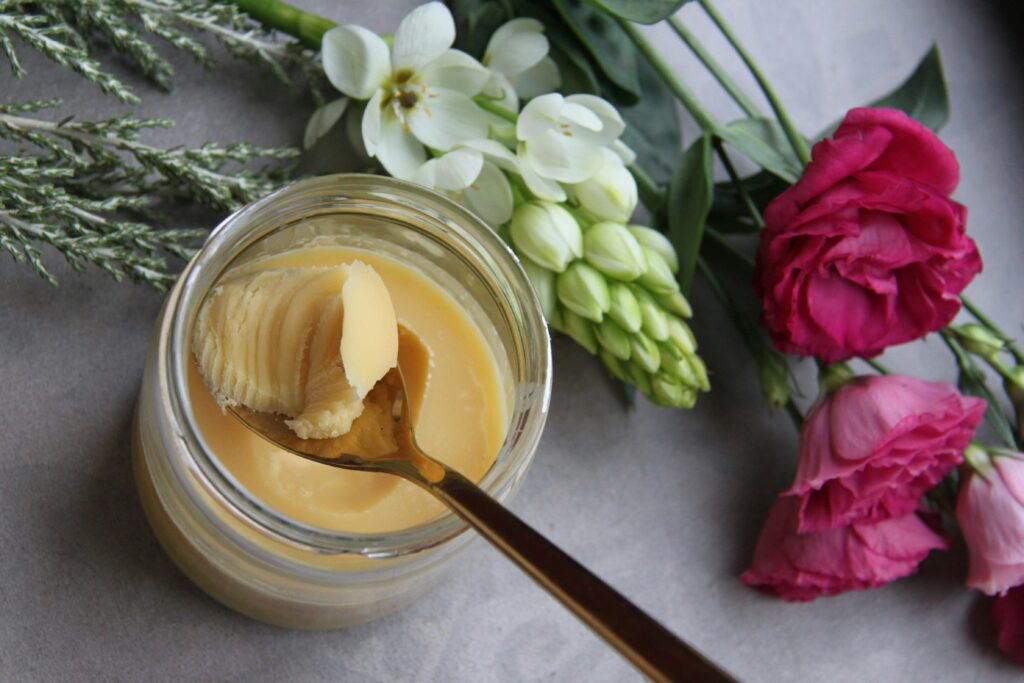The Return of Tallow: Trend or Transformation?
Tallow—rendered animal fat, typically from beef—has made a surprising comeback in the modern skincare world. Once relegated to old-fashioned soaps, it’s now being embraced by niche beauty brands and DIY formulators as a “natural,” “ancestral,” and supposedly “skin-identical” ingredient. The claims? That tallow is deeply moisturizing, full of vitamins, and more compatible with human skin than synthetic or even plant-derived oils.
But should we really be embracing animal fat in an era of advanced cosmetic science and plant-powered innovation? As a brand grounded in evidence and transparency, we took a close look at the science. Spoiler alert: while tallow has some promising features, it doesn’t outperform well-researched plant oils—and it comes with more unknowns than most skincare marketers let on.
- The Return of Tallow: Trend or Transformation?
- What Is Tallow, and Why Is It in Skincare?
- Moisturizing Power – How Does Tallow Perform?
- Safety Profile: What We Know, and What We Don't
- Tallow vs. Plant Oils – A Side-by-Side Look at Function, Feel, and Evidence
- Formulating with Tallow – When and How It Works
- Ethical and Environmental Factors – Does Sustainability Justify the Hype?
What Is Tallow, and Why Is It in Skincare?
Tallow is a type of fat obtained from rendering animal adipose tissue, often beef. When cooled, it becomes a semi-solid, waxy substance composed mostly of triglycerides—the same type of fat molecules found in human skin oils.
Because of this chemical similarity, some claim tallow is uniquely suited to nourish and protect our skin. But how well does this stand up to scientific scrutiny?

Fatty Acid Profile: Familiar, but Not Exceptional
Tallow is made up of four major fatty acids:
- Oleic acid (~47%)
- Palmitic acid (~24%)
- Stearic acid (~19%)
- Linoleic acid (~3%)
These are indeed present in human sebum and the outermost layer of skin (the stratum corneum), which supports the idea that tallow may help reinforce the skin barrier. But it’s important to note that tallow isn’t alone in this. Many plant oils also contain these same fatty acids—sometimes in higher, more beneficial ratios.
Table: Fatty Acid Composition Comparison
| Fatty Acid | Tallow (%) | Sunflower Oil (%) | Olive Oil (%) | Pumpkin Seed Oil (%) |
| Oleic Acid (C18:1) | ~47 | ~20 | ~70 | ~33 |
| Palmitic Acid | ~24 | ~5 | ~10 | ~15 |
| Stearic Acid | ~19 | ~4 | ~2 | ~7 |
| Linoleic Acid | ~3 | ~65 | ~10 | ~47 |

While tallow shares some lipids with human skin,
so do many plant oils
—often with higher levels of skin-beneficial linoleic acid.
Why Linoleic Acid Matters
Linoleic acid is a polyunsaturated omega-6 fatty acid that plays a key role in maintaining the skin’s moisture barrier. Low levels of linoleic acid in the skin have been linked to increased dryness, acne, and sensitivity.
Plant oils like pumpkin seed and safflower oil are especially high in linoleic acid, making them ideal for barrier repair. By contrast, tallow is relatively low in linoleic acid, meaning it may not provide the same skin-soothing and anti-inflammatory effects.
Vitamin Content: Theoretical, But Unproven
Tallow is often said to contain fat-soluble vitamins like A, D, E, K, and B12. While this is chemically true, current studies do not quantify these vitamins or show their actual skin effects when applied topically in tallow-based formulations. For a vitamin to be effective, it must be both present in meaningful concentrations and biologically available once applied to skin.
In contrast, many plant oils have been studied not only for their vitamin content but also for their clinical effects. For example, rosehip seed oil is known for its natural vitamin A content and has demonstrated anti-aging benefits in human trials.
Fun Fact: Sea buckthorn oil contains all four omega fatty acids (3, 6, 7, and 9) and is rich in vitamins C and E—making it a popular plant-based alternative with better documented benefits.
Moisturizing Power – How Does Tallow Perform?
Scientific Studies on Tallow’s Hydration Effects
According to a review by Russell et al. (2024), some basic science and comparative studies have shown that tallow-based emulsions provided moderate moisturization. In these tests, tallow outperformed certain polymer-based emulsifiers like xanthan gum and carboxymethyl cellulose in hydrating the skin.
However, when directly compared to plant-based oils, tallow was not the top performer.
Plant Oils That Outshine Tallow
The same studies noted that pumpkin seed oil and linoleic acid delivered superior hydration and barrier-repair benefits compared to tallow. These plant oils have not only a more favorable fatty acid profile but also anti-inflammatory and antioxidant properties.
Table: Moisturization Comparison
| Ingredient | Hydration Effectiveness | Anti-inflammatory | Evidence Base |
| Tallow | Moderate | Inconclusive | Limited, inconsistent |
| Pumpkin Seed Oil | High | Yes | Clinically supported |
| Linoleic Acid | High | Yes | Mechanistic + trials |
Texture and Sensory Feel
Tallow is a semi-solid at room temperature, giving it a rich, balm-like texture. This makes it suitable for products like lotion bars or healing salves. However, it may feel heavy or occlusive to some users, especially in humid climates.
Plant oils like jojoba, sunflower, and squalane offer similar emolliency with a lighter, faster-absorbing texture—a preferred sensory profile for most modern skincare users.

Tallow may act as a basic moisturizer, but if hydration, skin repair, and inflammation reduction are the goals, plant oils outperform.
Safety Profile: What We Know, and What We Don’t
Mixed and Inconclusive Safety Data
The safety of tallow in topical products remains under-researched. While some papers report no irritation to skin or eyes, others describe moderate to severe reactions, particularly in animal studies. Some trials found only eye irritation, others only skin irritation, and many used different scoring methods or reference points.
This inconsistency limits our understanding of how safe tallow truly is, particularly for sensitive or acne-prone skin types.
Lack of Human Testing and Standardized Evaluation
Most of the existing data comes from animal testing or in vitro models. There are no long-term studies, no standardized human patch testing, and no toxicological profiles like NOAEL (No Observed Adverse Effect Level) established for cosmetic-grade tallow.
For formulators and consumers alike, this represents a significant knowledge gap. It also complicates risk assessment, especially when marketing tallow-based products as safe for “all skin types.”
Regulatory Oversight
Tallow is permitted in both U.S. and EU cosmetics, but it’s not tightly regulated. Unless chemically modified (as in quaternium-18 hectorite), it doesn’t require detailed safety assessments.
In contrast, many plant oils are backed by detailed REACH dossiers, Cosmetic Ingredient Review (CIR) panel reviews, and decades of safe use in personal care products.
Pro Tip: If transparency and safety validation are priorities for you, choose INCI-listed plant oils that have been independently reviewed and clinically tested.
Tallow vs. Plant Oils – A Side-by-Side Look at Function, Feel, and Evidence
When it comes to moisturizers, it’s not just about whether an ingredient works—it’s about how well it works compared to safer, better-studied options. Many of tallow’s supporters highlight its similarity to skin lipids, but that’s not a unique claim. Plenty of plant-based oils offer the same benefits—and often more—with broader safety data and formulation flexibility.
Table: Tallow vs. Plant Oils on Key Skincare Performance Metrics
| Criteria | Tallow (Animal Fat) | Pumpkin Seed / Sunflower Oil (Plant-Based) |
| Primary Fatty Acids | Oleic, Palmitic, Stearic | Linoleic, Oleic, Phytosterols |
| Hydration in Comparative Studies | Moderate | Superior hydration and TEWL reduction |
| Anti-inflammatory Evidence | Not established | Supported by clinical data |
| Safety Profile | Mixed results; mostly animal studies | Human-tested with consistent safety outcomes |
| Comedogenic Potential | Poorly studied | Low (especially linoleic-rich oils) |
| Regulatory Review | Minimal oversight | REACH- and CIR-reviewed, globally accepted |
| Texture and Feel | Thick, waxy, semi-occlusive | Lightweight, fast-absorbing, flexible use |
Key Takeaway: Plant-based oils like pumpkin seed or sunflower oil are not only safer and more consistent across skin types, but they also offer better hydration and additional benefits like antioxidant support.
Pro Tip: If you’re prone to acne or inflammation, oils high in linoleic acid (like pumpkin seed or safflower) help calm the skin and support barrier recovery—without clogging pores.
Formulating with Tallow – When and How It Works
A 2021 formulation study found that lotion bars made with 40% beef tallow, shea butter, and beeswax were stable and offered good moisturization. These bars retained texture across heating and cooling cycles, and the tallow contributed to a semi-occlusive feel that was less greasy than expected.
That said, tallow didn’t outperform all oils tested. Plant-based oils—particularly those rich in unsaturated fats like linoleic acid—demonstrated higher moisturizing efficiency and better skin compatibility in comparative tests. In short, while tallow can work, it isn’t exceptional.
When Tallow Makes Sense in Formulations:
- In anhydrous products (formulas without water), like balms and lotion bars, where its solid structure helps with texture.
- For consumers specifically seeking ancestral or animal-based skincare.
When It Doesn’t:
- In emulsions and creams where plant oils provide more hydration and user comfort.
- When seeking added antioxidant, anti-inflammatory, or skin-brightening effects—tallow has not been clinically shown to offer these benefits.
Formulation Verdict: Tallow is functional but not outstanding. In most use cases, better-tested and more elegant options already exist.
Ethical and Environmental Factors – Does Sustainability Justify the Hype?
Tallow advocates often highlight its sustainability: it’s a byproduct of meat processing, so using it avoids waste. While that’s true, the bigger picture matters.
Tallow’s Ethical Trade-offs:
- It is not vegan or cruelty-free.
- Its source is often non-transparent; most manufacturers don’t provide rendering method or livestock origin.
- Some consumers find its animal origin off-putting or misaligned with their values.
Tallow’s Environmental Pros:
- Utilizes waste from the meat industry.
- Doesn’t require new land or farming infrastructure.
But Compare That To… Certified Plant Oils:
- Can be organically grown and cold-pressed (retaining nutrients, avoiding chemical processing).
- Compatible with vegan, halal, kosher, and cruelty-free formulations.
- Traceable through fair-trade and sustainability certifications.
- Often carbon-labeled and monitored for biodiversity impact.
Key Takeaway: While tallow might offer a waste-reduction angle, its ethical and environmental profile lacks the clarity and alignment modern skincare consumers demand.
Our Final Verdict – Why We Stick with Science-Backed Plant Oils
At DrBeautiology, our brand stands for transparency, efficacy, and evidence. That means we don’t jump on trends unless the science checks out.
Where Tallow Stands:
- It contains skin-identical lipids.
- It may help retain moisture in rich, balm-based products.
- It has historical use and a certain appeal in the “ancestral skincare” niche.
But Here’s Why We Don’t Use It:
- Inconsistent Safety Record: Studies conflict on whether tallow causes irritation. Most data comes from animals, not humans.
- Lack of Comparative Superiority: When pitted against oils like pumpkin seed, tallow doesn’t win in hydration, safety, or functionality.
- Narrow Formulation Use: It works well in a balm but lacks the versatility needed in modern skincare systems.
- Ethical Concerns: Its animal origin excludes it from vegan and cruelty-free categories, making it less inclusive.
What We Recommend Instead:
- Pumpkin Seed Oil: Clinically shown to hydrate and reduce inflammation.
- Rosehip Oil: Known for vitamin A content and proven photodamage repair.
- Sea Buckthorn Oil: Antioxidant-rich with ORAC backing and barrier-boosting effects.
- Oat Oil: Soothes and strengthens reactive skin, supported by human patch testing.

Tallow isn’t harmful in every case. But when better-studied, more inclusive, and multifunctional options exist, we simply don’t see the need to settle for less.
The goal of clean beauty should never be to go backward. It should be to move forward, grounded in modern science, not ancient assumptions.
What is your take? Did tallow work or not for you?
Talk to you soon!
Dr Bozica
References:
https://japsonline.com/abstract.php?article_id=3447
https://pmc.ncbi.nlm.nih.gov/articles/PMC11193910/
https://www.sciencedirect.com/science/article/pii/S2351978919309862